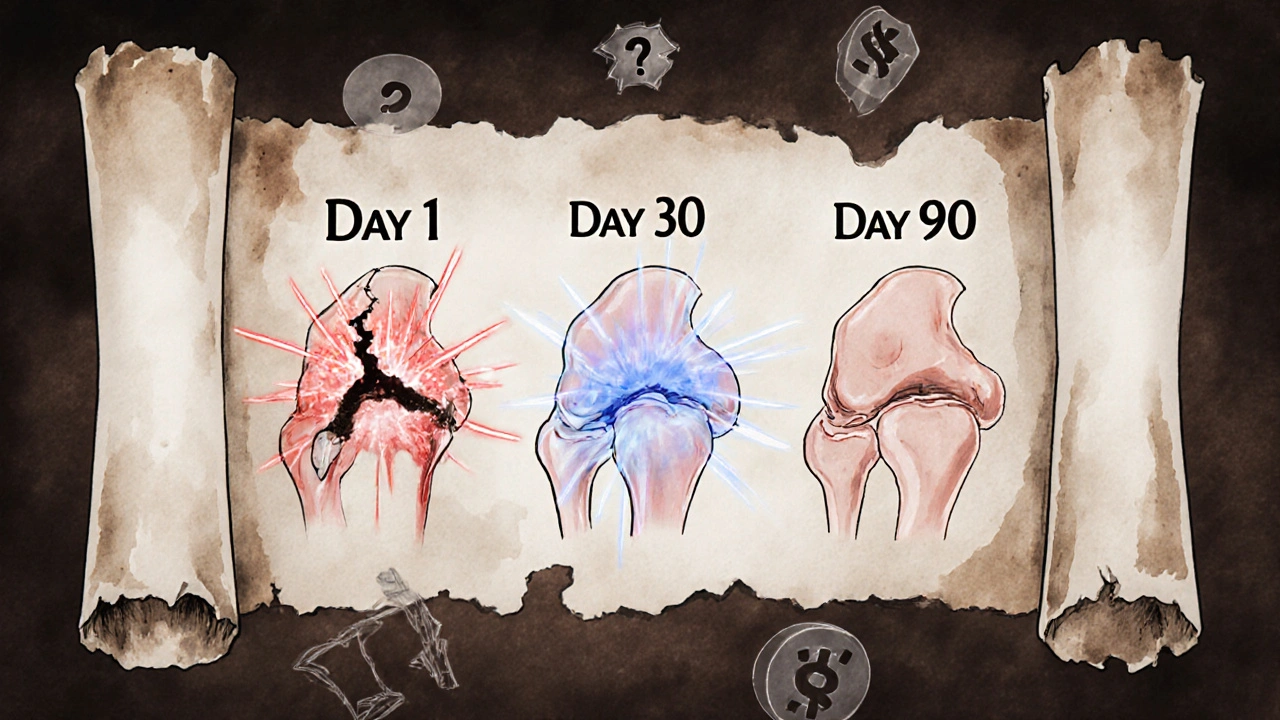Osteoarthritis Treatment Comparison Tool
Find Your Best Osteoarthritis Treatment
Compare Diacerein (Cartidin) with common alternatives based on your priorities and medical needs.
Your Treatment Priorities
Cartidin, which contains the active ingredient Diacerein, is a slow-acting drug used to treat osteoarthritis, especially in the knees and hips. Unlike painkillers that mask symptoms, Diacerein works by targeting the inflammation and cartilage breakdown that cause joint damage over time. But it’s not the only option. Many people wonder: Is Cartidin better than glucosamine? Should I switch to a NSAID? What about newer treatments? Let’s break down how Diacerein stacks up against the most common alternatives - with real-world pros, cons, and what actually works for people.
What is Diacerein (Cartidin) and how does it work?
Diacerein is a plant-derived compound that breaks down into rhein in the body. Rhein blocks interleukin-1 beta, a key chemical that drives joint inflammation and cartilage destruction in osteoarthritis. This means Diacerein doesn’t just reduce pain - it may actually slow down the disease process. That’s why it’s called a disease-modifying osteoarthritis drug (DMOAD).
But it’s slow. You won’t feel better in a few days. Most people start noticing improvements after 2 to 4 weeks, with full effects taking up to 3 months. That’s a big difference from fast-acting painkillers. It’s also not a cure. It won’t rebuild cartilage, but studies show it can reduce joint space narrowing over time compared to placebo.
Cartidin is typically taken as a 50 mg capsule once or twice daily, usually with food to reduce stomach upset. It’s approved in Europe, Latin America, and parts of Asia, but not in the U.S. The FDA rejected it in the early 2000s due to safety concerns around diarrhea and liver effects.
Glucosamine and Chondroitin: The Popular Over-the-Counter Option
Glucosamine and chondroitin sulfate are the most widely used supplements for osteoarthritis. They’re sold together in capsules, tablets, or liquids, and many people take them without a prescription.
Here’s the reality: studies show mixed results. Some trials, like the large NIH-funded GAIT study, found that for people with moderate to severe knee pain, the combo worked about as well as Celebrex (a prescription NSAID). But for mild pain? Not much better than a placebo.
Compared to Diacerein:
- Glucosamine/chondroitin works slower - often 6-8 weeks to notice anything.
- It’s much safer. Side effects are rare and mild - maybe a little bloating or nausea.
- It doesn’t require a prescription and is cheaper long-term.
- But it doesn’t have the same anti-inflammatory power as Diacerein.
If you’re looking for a gentle, low-risk option to try first, glucosamine is a good starting point. But if you’ve tried it for 3 months and feel no difference, switching to Diacerein might make sense - if it’s available in your country.
NSAIDs: Fast Relief, But With Risks
Drugs like ibuprofen, naproxen, and diclofenac are the go-to for quick pain relief. They work within hours. That’s why most people reach for them first.
But NSAIDs come with trade-offs:
- They don’t slow joint damage - they just hide the pain.
- Long-term use raises risk of stomach ulcers, kidney damage, and heart problems.
- People over 65 or with high blood pressure are often told to avoid them.
Diacerein doesn’t carry those risks. It’s gentler on the stomach and kidneys. But it doesn’t help when you need immediate relief after a bad day of walking or lifting.
Many doctors recommend using NSAIDs short-term for flare-ups, then switching to Diacerein for long-term control. It’s not either/or - it’s both, used strategically.
Acetaminophen (Paracetamol): The Middle Ground
Acetaminophen is often the first choice for mild osteoarthritis pain because it’s widely available and has fewer side effects than NSAIDs. But here’s the catch: it’s not anti-inflammatory. It doesn’t touch the root cause of joint damage.
Studies show it’s less effective than NSAIDs for moderate to severe osteoarthritis. For some people, it barely helps at all. Diacerein, on the other hand, targets inflammation directly.
Use acetaminophen if you can’t tolerate NSAIDs or need a quick fix. But if your pain is persistent and getting worse, Diacerein offers something acetaminophen can’t - potential disease modification.

Other Prescription Options: Hyaluronic Acid Injections and Celecoxib
Hyaluronic acid injections (like Synvisc or Orthovisc) are given directly into the knee joint. They’re meant to replace the natural lubricant that wears out in osteoarthritis. Some patients get relief for 6 months or more. But the evidence is mixed. The American Academy of Orthopaedic Surgeons doesn’t recommend them routinely because many studies show little benefit over saline injections.
Celecoxib (Celebrex) is a COX-2 inhibitor NSAID. It’s easier on the stomach than older NSAIDs, but still carries cardiovascular risks. It’s fast-acting and strong - but again, it doesn’t change the disease.
Diacerein is different. It’s oral, not injected. It’s slower, but it’s the only oral medication in this list that’s shown potential to slow cartilage loss over years. If you’re looking for a long-term strategy, not just symptom control, Diacerein stands out.
What About Newer Treatments? PRP, Stem Cells, and Supplements Like Collagen
PRP (platelet-rich plasma) and stem cell injections are getting buzz. They’re expensive - often $1,000 per injection - and not covered by insurance. Studies are small and inconsistent. Some people report relief; others feel nothing. There’s no solid proof they slow osteoarthritis progression.
Collagen supplements (hydrolyzed collagen) are another popular option. Early research suggests they might help reduce joint pain and improve mobility, possibly by supporting cartilage structure. But the evidence is weaker than for Diacerein. One 2023 meta-analysis found collagen worked better than placebo, but the effect size was small.
Neither PRP, stem cells, nor collagen have the same level of long-term data as Diacerein. If you’re considering these, do it as a supplement - not a replacement - to a proven treatment like Diacerein.
Side Effects: Diacerein vs. the Rest
Diacerein’s biggest downside is gastrointestinal upset. About 20-30% of users get diarrhea, especially at the start. It’s usually mild and goes away after a few weeks. Taking it with food helps. Some people switch to a lower dose (25 mg twice daily) to reduce this.
Compared to other options:
- NSAIDs: Higher risk of ulcers, bleeding, kidney issues.
- Glucosamine: Very low risk, maybe mild bloating.
- Acetaminophen: Safe if under 3,000 mg/day, but liver damage risk if mixed with alcohol.
- Injections: Risk of infection, swelling, or temporary pain at injection site.
For most people, the diarrhea from Diacerein is a manageable trade-off for avoiding the serious risks of long-term NSAID use.

Who Should Use Diacerein? Who Should Avoid It?
Good candidates for Diacerein:
- People with moderate to severe knee or hip osteoarthritis who need long-term control.
- Those who can’t take NSAIDs due to stomach, kidney, or heart issues.
- Patients who’ve tried glucosamine without success.
- Anyone looking to reduce reliance on painkillers.
Avoid Diacerein if you:
- Have severe liver disease (it’s metabolized by the liver).
- Have a history of severe diarrhea or inflammatory bowel disease.
- Are pregnant or breastfeeding (not enough safety data).
- Are under 18 (not studied in children).
Always talk to your doctor before starting or switching. Blood tests may be needed to check liver function before and during treatment.
Final Take: Where Does Diacerein Fit In?
Diacerein isn’t perfect. It’s slow. It can cause stomach issues. And it’s not available everywhere. But it’s one of the few oral medications that might actually change the course of osteoarthritis - not just mask it.
Here’s a simple way to think about your options:
- Need fast relief? Use NSAIDs or acetaminophen - short-term only.
- Want something safe and gentle? Try glucosamine/chondroitin for 3-6 months.
- Have persistent pain and want to protect your joints long-term? Diacerein is your best bet among oral meds.
- Want cutting-edge? Consider collagen or PRP - but know the evidence is weak and costs are high.
If you’re in a country where Cartidin is available, and you’re tired of popping painkillers that don’t fix the problem, it’s worth a try. Give it 3 months. Track your pain levels. Talk to your doctor about liver tests. And don’t expect miracles - but do expect a better, more sustainable way to manage your joint health.
Is Diacerein better than glucosamine for osteoarthritis?
Diacerein is more effective at reducing inflammation and may slow joint damage over time, while glucosamine offers mild symptom relief with fewer side effects. Diacerein is a prescription drug with stronger evidence for disease modification; glucosamine is an over-the-counter supplement with inconsistent results. If glucosamine doesn’t help after 3 months, Diacerein is a logical next step - if available.
Why isn’t Diacerein available in the United States?
The FDA rejected Diacerein in the early 2000s due to safety concerns, primarily related to diarrhea and potential liver toxicity. While studies showed benefit for osteoarthritis, the agency determined the risks outweighed the benefits for the U.S. population. It remains approved in over 60 countries, including those in Europe and Latin America, where it’s considered a standard treatment.
Can I take Diacerein with NSAIDs?
Yes, many people use Diacerein alongside NSAIDs - especially during flare-ups. Diacerein works slowly to reduce joint damage, while NSAIDs provide quick pain relief. Doctors often recommend this combo: use NSAIDs short-term for pain, then rely on Diacerein for long-term control. Always check with your doctor to avoid overuse of NSAIDs.
How long does it take for Diacerein to work?
Diacerein is slow-acting. Most people notice reduced pain and stiffness after 2 to 4 weeks, but full benefits can take 3 months or longer. This is because it targets the underlying inflammation and cartilage breakdown, not just symptoms. Patience is key - it’s not a quick fix, but a long-term strategy.
What are the most common side effects of Diacerein?
The most common side effect is diarrhea, affecting 20-30% of users, especially at the start of treatment. It’s usually mild and improves after a few weeks. Taking the capsule with food helps reduce this. Less common risks include liver enzyme changes, which is why doctors sometimes recommend blood tests before and during treatment. Severe side effects are rare.
Is Diacerein safe for older adults?
Yes, Diacerein is often preferred for older adults over NSAIDs because it doesn’t raise the risk of stomach bleeding, kidney damage, or heart problems. However, liver function should be monitored, especially in those over 70 or with pre-existing liver conditions. Always start with the lowest effective dose and adjust under medical supervision.
Next Steps: What to Do If You’re Considering Diacerein
If you’re thinking about switching to Diacerein:
- Check if it’s approved and available in your country.
- Talk to your doctor about your current pain management - especially if you’re using NSAIDs regularly.
- Ask if a liver function test is needed before starting.
- Start with 50 mg once daily, then increase to twice daily if tolerated.
- Track your symptoms: use a pain diary or app for 3 months.
- Don’t stop other treatments abruptly - combine smartly under guidance.
There’s no one-size-fits-all solution for osteoarthritis. But if you’re tired of masking pain and want something that might actually help your joints stay healthier longer, Diacerein is one of the few options that delivers on that promise - if you’re willing to wait for results and manage the side effects.


Sage Druce
October 30, 2025 AT 10:00Took 10 weeks to feel it but now I can walk my dog without wincing
No more ibuprofen every other day
Yeah the diarrhea sucked at first but I cut the dose to 25mg and it vanished
Worth every second
Tyler Mofield
November 1, 2025 AT 08:22Comparative efficacy studies against glucosamine demonstrate statistically significant reduction in joint space narrowing at 24 months p<0.01
However regulatory agencies such as the FDA have declined approval due to unfavorable risk-benefit ratio regarding gastrointestinal and hepatic adverse events
Patrick Dwyer
November 1, 2025 AT 21:21Many of us have to work around what's available
I've had patients switch from NSAIDs to glucosamine then to diacerein when they could get it overseas
It's not perfect but it's one of the few that actually targets progression
Patience and monitoring make all the difference
Bart Capoen
November 3, 2025 AT 15:15Switched to diacerein when I was in Germany last year
First 3 weeks I was like wow why am I pooping so much
Then at week 8 my knee stopped creaking like a rusty gate
Still take tylenol if I overdo it but now I dont feel like my joints are crumbling
Just sayin
Cecil Mays
November 5, 2025 AT 03:51Don't give up at week 2
Trust the process
You're not just treating pain you're protecting your joints for the future
And yes diarrhea sucks but it gets better
Go for it 💪
Karen Werling
November 6, 2025 AT 18:56My mom has severe OA and she's on it too
We both get the stomach thing but we take it with dinner and it's fine now
She stopped her NSAID and her blood pressure improved
It's slow but it feels like we're doing something real not just covering up the problem
STEVEN SHELLEY
November 8, 2025 AT 14:43Glucosamine is $15 a bottle and they make billions off NSAIDs
Diacerein is plant based and can't be patented
Same reason they banned turmeric supplements and push opioids
Ask yourself who profits
Emil Tompkins
November 9, 2025 AT 23:47Kevin Stone
November 11, 2025 AT 18:08It's a scam marketed to the elderly
If you're not on diacerein you're not serious about your joint health
And if you're on NSAIDs long term you're basically asking for a stroke
Natalie Eippert
November 13, 2025 AT 02:11Other countries are reckless
We don't need foreign drugs with unknown side effects
Glucosamine is safe and natural
Why risk your liver for something that's not even approved here
Stay safe stay American
kendall miles
November 13, 2025 AT 23:15My doctor said it's not even on the radar in the US
It's weird how different countries treat the same science
But I'm not surprised
They're all controlled by the same corporate interests
Just like with insulin and epipens
Gary Fitsimmons
November 15, 2025 AT 17:42My dad started diacerein last year and he's walking again
He used to hate going out
Now he takes his grandkids to the park
It's not magic but it's real
And it gave him his life back
Bob Martin
November 16, 2025 AT 05:47And the FDA would rather we take pills that give us ulcers and heart attacks?
That's not medicine that's a punchline
luna dream
November 17, 2025 AT 08:53Our bodies are meant to break down
And they're trying to force us into a system of control
Diacerein is just another tool of the medical-industrial complex
Maybe the answer is to stop fighting aging
Maybe the pain is the message
Linda Patterson
November 18, 2025 AT 02:36It's just sugar and chalk
And anyone who says diacerein is safe hasn't read the case studies
Liver failure is real
And the FDA isn't wrong to ban it
People need to stop chasing miracle cures and start accepting reality